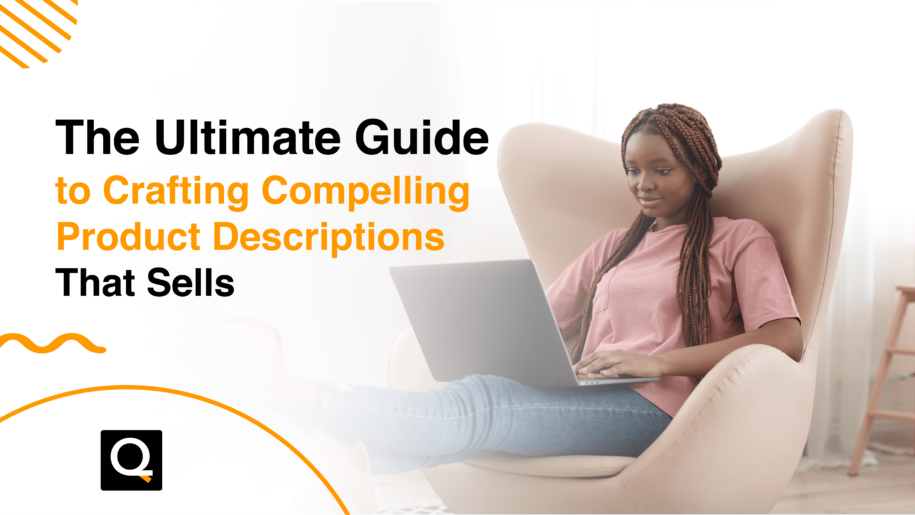Stand Out and Sell More: Mastering the Art of Product Descriptions
Hey there, ecommerce business owners! As an online business owner, you know firsthand how competitive the online market space is, where competition is fierce and attention spans are fleeting, standing out online can feel impossible. But it’s not just about the product you’re selling; it’s about how you present it.
What if I told you that the key to boosting your sales could be found in just a few lines of text? That’s right, your product descriptions could be the secret weapon you’ve been overlooking. When done right, product descriptions are more than just information. They’re the bridge that connects your potential customers with the emotional experience of your product.
The Problem: Many e-commerce business owners struggle to create descriptions that capture attention, build trust, and convert browsers into buyers.
The Solution: A well-crafted, compelling product description that sells the product as an experience, a solution, and even an emotion. In this guide, you’ll discover how to transform bland descriptions into powerful sales drivers.
Why Product Descriptions Matter More Than You Think
Product descriptions are more than just a list of features or specs. They are your opportunity to:
- Grab a potential customer’s attention instantly.
- Build trust and communicate value.
- Differentiate your brand from competitors.
- Drive sales and increase conversions.
When done right, they create an emotional connection that helps customers see themselves using the product. Think about it, when was the last time you bought something online without reading the description? Customers crave clarity, confidence, and reassurance before making a purchase.
Crafting Product Descriptions That Sell: Key Ingredients
What makes a product description truly stand out? Is it:
- Flawless grammar?
- A long list of technical features?
- Or something deeper?
The answer lies in a mix of psychology, storytelling, and SEO optimization. Let’s dive in!
The Power of Target Audience Segmentation
Before you can create a winning description, you need to know who you’re talking to. Are your products aimed at budget-conscious shoppers, luxury enthusiasts, or eco-friendly consumers? The more specific you can be about your audience, the more effective your descriptions will be.
For example, a product description for a luxury leather handbag aimed at fashion-forward professionals will read very differently from one for an affordable, everyday tote bag targeting students.
Here are three key segments to consider:
- Value-driven customers – They want quality at the best price. Highlight affordability and durability.
- Luxury shoppers – They look for premium materials and exclusivity. Focus on craftsmanship and unique features.
- Eco-conscious buyers – Sustainability is their priority. Emphasize eco-friendly practices and materials.
Example:
- Before: “This tote bag is made from leather and has ample storage.”
- After (luxury segment): “Crafted from premium Italian leather, this sophisticated tote offers an elegant blend of style and functionality, ensuring you stay organized without sacrificing fashion.”
The Role of SEO in Product Descriptions: Best Practices
SEO (Search Engine Optimization) is crucial for making sure your products are discoverable online. Writing for SEO doesn’t mean stuffing your description with keywords, it means using strategic keywords naturally while maintaining a customer-first approach.
Here’s a checklist for best practices:
- Keyword Research: Identify relevant keywords and long-tail phrases your audience searches for.
- Placement: Incorporate primary keywords in the product title, first 100 words, and meta descriptions.
- Use Synonyms: Avoid repetition by using natural synonyms that a user might search for.
- Bullet Points: Utilize bullet points for easy readability and to highlight key features for search engines.
- Alt Text: Don’t forget to optimize images with alt text that includes relevant keywords.
- Length: Keep descriptions between 100-200 words because it will be enough to inform and concise enough to hold attention.
Example:
- Before: “This winter jacket is great for cold weather.”
- After (SEO-optimized): “Stay warm this winter with our insulated, water-resistant winter jacket, designed for extreme cold weather. Perfect for outdoor activities, this lightweight jacket combines style and function.”
Steps to Craft a Compelling Product Description
Follow these steps to make your product descriptions resonate with your target audience:
- Know Your Customer: Understand their needs, desires, and pain points.
- Find Your Voice: Reflect your brand’s personality, whether it’s fun, quirky, professional, or elegant.
- Highlight Benefits, Not Just Features: Focus on how the product will improve your customer’s life.
- Use Sensory Language: Help the customer visualize and feel the product. Describe textures, colors, and sensations.
- Keep It Concise: Eliminate unnecessary words. Each sentence should add value.
- Incorporate Social Proof: Add customer testimonials or reviews to build trust and credibility.
- Optimize for SEO: Follow best practices to increase visibility while keeping the language natural.
Best Practices for Product Descriptions
- ☐ Use customer-focused language.
- ☐ Prioritize benefits over features.
- ☐ Include keywords naturally.
- ☐ Optimize titles, meta descriptions, and image alt text.
- ☐ Keep sentences short and impactful.
- ☐ Use storytelling to connect emotionally.
- ☐ Add a call to action.
☐ Integrate customer reviews and testimonials.
Case Study: Before and After Product Transformation
Before:
“This watch is water-resistant and has a leather strap. It shows the time accurately.”
After:
“Elevate your style with this sleek, water-resistant timepiece. Featuring a genuine leather strap and precision-engineered movement, this watch is designed for the modern professional who values both style and performance. Whether you’re at the office or on an adventure, this watch will keep you on time and in style.”
Notice how the second description goes beyond features to paint a picture of the product’s impact on the buyer’s lifestyle.
If you follow these strategies and optimize your descriptions, you’ll not only capture attention but also convert online window shoppers into loyal customers. Your product descriptions are an invitation, a chance to connect, convince, and convert. Don’t settle for less; write descriptions that sell. Also, if you are ready to take your online business global, this is the chance to do that. Read this to know more.


